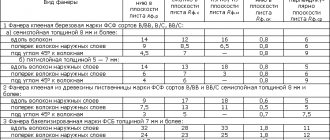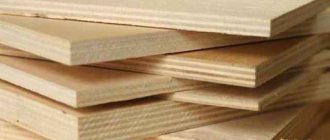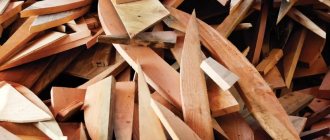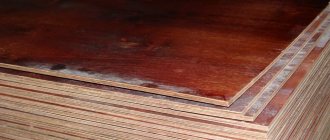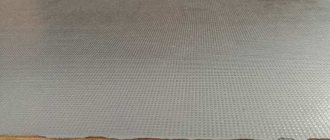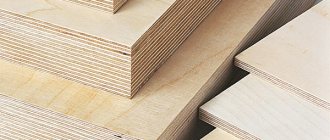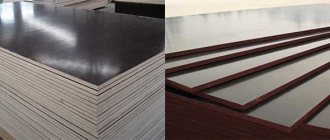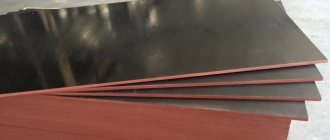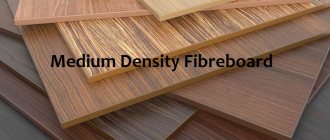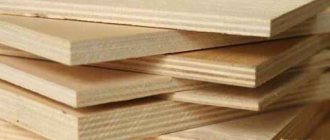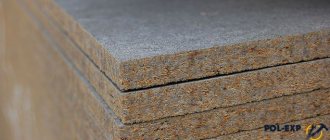Aviation plywood | Use of aircraft plywood
Aviation plywood is made from high-quality birch veneer, has three or more layers glued together, and, with its relatively low density, has excellent flexibility and strength. Thus, aircraft type plywood with a thickness of three to sixteen millimeters or even more can be used not only for aircraft modeling, but also for musical instruments. The thinnest sheet can be 1 mm thick.
Let's talk about what properties the material for making structures has, as well as what brands it has and where it is used.
Manufacturing of aircraft plywood
This type of plywood is also called delta wood, which is essentially similar to aircraft plywood, because it is made from exactly the same birch veneer with the addition of plastic. Before gluing the layers with bakelite adhesive, they should be impregnated with phenol-formaldehyde resin at a temperature of 270 degrees and a pressure of six atmospheres. This material is produced only in accordance with GOST 226-41, and also has grades A and B.
Production and marking of aircraft plywood
Thus, the products can be divided into several grades: BP (A or B) - this applies to this type of plywood sheets that are glued with bakelite film type A or B. There is also the BS-1 grade, in which the veneer is glued using SFZh-resin 3011 and BPS-1V. This indicates that up to three millimeters the product is glued to a bakelite film with type B, and then the same with type A is used, but only on the outer layer, and resin is used on the inside.
When producing plywood with this marking, it is necessary that the veneer be positioned perpendicularly. In other words, in their direction, the fibers of each layer intersect with each other, thereby creating something like a structural lattice, with the help of which the strength of the manufactured structures becomes much greater.
The increase in strength level related to the tensile strength of structural wood directly depends on its decreasing thickness and for products with the first grade is 65-95 MPa and the second - 50-82.5 MPa. If the thickness of the material becomes smaller, then its tensile strength, on the contrary, becomes greater. This concerns the formation of chips in the adhesive layer. Their size ranges from 1.6-2 MPa. The most optimal level of surface roughness for aircraft plywood sheets is 100 microns at a moisture level of 5-9%.
The length of the geometric data of this type of wood ranges from 1000 to 1525 mm, and the width from 800 to 1525 mm. The permissible gradation value is twenty-five millimeters. Sheets with the BP brand (A or B) can have a thickness from one to three millimeters, but for BS up to twelve, and for BPS from two to six.
Thus, aircraft-type plywood formats can have dimensions: 1550x1550, 1525x1525, 1270x1270, 1220x1220. With all this, the thickness can be of various sizes from 0.4 to 12 millimeters.
Any type of plywood is manufactured according to instructions drawn up in accordance with GOST 3916.1-96. The sheet must have an odd number of layers, and the fibers are arranged perpendicular to each other at an angle of ninety degrees, forming a structural lattice. As for the production process of such products, it has several specific stages. Plywood may be marked with the letters Ш and Ш2, which indicates that one-sided or two-sided sanding was carried out. Low grade plywood is not sanded and is marked with the letters NSh.
Applications of aircraft plywood
It has long been known that this type of structural wood was widely used for the construction of aircraft, especially during the war. Due to the fact that the material is relatively light in weight, the car was lightweight, and thanks to its flexibility and strength, it became possible to withstand the aerodynamic load during aircraft operation. Although, in aircraft modeling, aircraft plywood is still used today. In addition to being used in aircraft construction, such plywood sheets are popular in collecting (airplanes or ships). In addition, this material has also gained wide popularity in shipbuilding.
During the architectural machinations of any unique solutions for the construction of various structures (buildings, cities, houses), designers independently make models. On their basis, projects are approved. In addition, with the help of flexible plywood, you can implement non-standard solutions in interior design.
It would also be strange not to mention that musical instruments are made from
aircraft plywood . For their production previously it was impossible to do without high-quality plywood sheets. Each of the soundboard instruments requires the use of special wood, and over the past few years, replacing it with plastic has not justified itself; the best sound quality can only be achieved by using natural wood.
Any plywood of the type in question with a thickness of one or more millimeters can always be used at home. Also, some craftsmen can independently assemble furniture from it in several different styles, thereby achieving the beauty of living conditions.
mosfanera.ru
Northern part of Moscow
SAO - Airport, Begovoi, Beskudnikovsky, Voikovsky, Vostochnoye, Degunino, Golovinsky, Dmitrovsky, Western Degunino, Koptevo, Levoberezhny, Molzhaninovsky, Savelovsky, Sokol, Timiryazevsky, Khovrino, Khoroshevsky)
NEAD - Bogorodskoye, Veshnyaki, Eastern Izmailovo, Vostochny, Golyanovo, Ivanovskoye, Izmailovo, Kosino-Ukhtomsky, Metrogorodok, Novogireevo, Novokosino, Perovo, Preobrazhenskoye, Northern Izmailovo, Sokolinaya Gora, Sokolniki)
Northwestern Administrative Okrug - Kurkino, Mitino, Pokrovskoye-Streshnevo, Northern Tushino, Strogino, Khoroshevo-Mnevniki, Shchukino, Southern Tushino)
Also, we deliver plywood to the Eastern, Western and Southern parts of Moscow: Central Administrative District, Eastern Administrative District, South-East Administrative District, Southern Administrative District, South-Western Administrative District, ZAO, Zelenogradsky, Troisky, Novomoskovsky administrative districts of the city of Moscow.
FC plywood - grades, sizes, brands
In our time of constant development of building materials, plywood manufacturers could not stop there, although they had already created one of the most popular materials on the planet. Therefore, various modifications of plywood began to appear, which acquired more and more positive and necessary properties. One of these extremely useful modifications in production was FC plywood, the characteristics of which are head and shoulders above the standard version of the material.
What is FC plywood?
General purpose plywood of the FK brand is a waterproof type of material, which, meanwhile, has good environmental safety indicators. FC's direct competitor, FSF plywood, cannot boast of such properties. FSF and FK plywood, the differences of which are quite extensive, are the exact opposite of each other - if the second has average water resistance, but is also environmentally friendly, the first offers extremely high resistance, but threatens its owners with many diseases due to harmful fumes.
The properties of FC plywood are determined by the adhesive mass with which the product is processed. These glues are urea preparations, which are used equally in both softwood and hardwood plywood.
Since FK grade plywood has relatively low moisture resistance, it is mainly used when treating interior walls of a home. The best way to use this material is to treat walls in wet areas - kitchens, bathrooms, showers and saunas. Also, the FC grade of plywood is very often used in the production of furniture, mainly for outdoor use.
The abbreviation FK stands for as follows: K - urea glue, F - plywood. FC plywood, the technical characteristics of which allow the material to be used in a huge list of tasks, has the following main advantages over its competitors:
- it has a standard humidity of five to ten percent;
- waterproof plywood FC has good protection from weather conditions;
- This type of plywood is an ideal solution for finishing complex indoor rooms.
It is worth noting that even FC plywood 10 mm or more has a fairly low price if you look at competitors’ analogues.
Types of plywood of this type
Like any other plywood, FK brand material is divided into different grades based on the quality of processing and base. The higher the grade, the higher the price, but the quality also increases by an order of magnitude. The following varieties of this material are distinguished:
- FC plywood (10 mm and below) “elite” type. An ideal quality material, which is produced mainly to order from the best selected tree trunks. When producing such material, the best veneer is selected, which has no flaws in the form of knots or damaged surface. When the veneer is glued, the plywood is covered with cellophane film and sent straight to the customer.
- FC plywood grade 1 1. A very high quality material that is used for interior design or the construction of individual furniture. Possible defects are surface damage one per half square meter, small cracks barely visible to the eye. Knots are allowed - both preserved and fallen, but not more than 2 mm.
- FC plywood grade 2 2. Average quality, which is used almost everywhere. Possible defects - surface damage is one per 5% of the total sheet area. There may be inserts from other wood of similar design and color, as well as sap leakage. All listed defects should not be more than 10 cm per 2% of the entire area.
- plywood FC grade 3 3. Rejected plywood that does not pass the criteria of grade 2, but also does not move to the fourth position. May have disadvantages, which include the width of edge defects and veneer overlaps of no more than twenty centimeters. Often clients are interested in FK 3 4 plywood, since work in which third-grade material is used does not require a strong core. Interestingly, many people buy this type of material specifically for interior design, where there is a need for natural wood covering.
- plywood FC 4 4th grade. The lowest quality grade of plywood, which is used mainly for interior finishing work. Material defects can reach a diameter of 40 mm, with knots and wormholes penetrating 5 mm. Despite the apparent “defectiveness” of the material, FK 4 4 plywood is the most purchased type of this type among consumers on the Russian market.
This list shows only those FC plywood options whose front and inner sides are the same. This is clear from the markings - the first number after the abbreviation indicates the grade of face veneer, the second - internal veneer. However, any consumer can choose a combined type of plywood, where the front and inner veneers differ in quality. For example, FK 3 4 plywood, where the front veneer is grade 3, and the inner veneer is grade 4.
FC birch plywood or pine needles – which option is better?
Many builders and buyers are confused about which material option is better - FC birch plywood or a coniferous type of product. In fact, comparing these types of material is like trying to choose a tourist trip to France and to America. It is clear that both states are tourist centers, but they are completely different. To better decide which type of plywood FC 12 mm and smaller is better, it is worth comparing their properties in this table:
| Advantages of coniferous plywood | Advantages of birch plywood |
| Very beautiful surface texture that has intricate patterns | Remarkable surface structure with beautiful bright color and light shade |
| Low specific gravity, which makes softwood plywood more pleasant during high-rise work and processing houses made of sandwich panels | The quality of grinding is at a high level, higher than that of competitors |
| Resistance to mechanical damage | Smooth surface that can be further enhanced with varnishes |
| Has a natural anesthetic that repels pests and various molds | The ability to create large sheets of material while maintaining their high strength |
It is worth noting that in fact there are many more types of trees from which FC plywood of 4 mm and above is made. However, these two types are the most easily accessible and cheapest, while having high efficiency characteristics, so they are mainly purchased.
According to statistics, FC birch plywood is still more popular than its competitor’s products. It is this tree that is publicly available, and besides, birch is not used practically anywhere else except in the production of plywood, so its price is significantly lower. In addition, FC 21 mm made from birch has incredible flexibility and strength, which allows the material to be used in a wider range of jobs than pine needles.
FK Sh2, Sh1 or NSh plywood – which option to choose?
Also, the main differences between plywood include the degree of sanding. It is designated in the markings by the letter Ш or НШ. For example, Sh1 is FC plywood sanded from the front side, Sh2 is FC 4 mm plywood sanded from two turns, NSh is FC plywood unsanded. This plywood is created for different purposes, since FK NSh plywood is more useful for creating a natural interior, while the sanded version is suitable for subsequent painting and other processing.
Although the sanded version of plywood is more popular, despite its high cost. The fact is that this version of plywood is most suitable for engineering and construction, since additional sanding gives the material higher rigidity and strength. And since FC plywood 15 mm and above is a type of structural product, these characteristics are fundamental for the material. The plywood is also additionally sanded for subsequent cross-lamination of the product, after which the plywood becomes ideal in terms of strength/weight and width/length.
As a result of such improvements, sanded plywood FK 1 1 and other grades have received very high resistance to chemical and physical influences, so they are best suited for industrial use.
However, do not forget about the features of unpolished FC. FC VVS plywood (as grade 3 of the material used to be designated) unsanded is often used for technical work, in the creation of cable drums, racks, liquid tanks, pallets, pallets, and other warehouse equipment. It is also often customary to store soft products that must have retention points in containers made of unsanded FC plywood. After all, if such fragile vegetables or fruits are placed in more abrasive containers, then the products will most likely slide inside the boxes and become deformed.
Where is FC plywood used?
Since FK 15 plywood has properties of increased resistance to moisture, the breadth of its application is very diverse. In addition to this property, plywood of this type is available in a wide variety of sizes. All parameters of the material comply with GOST, the humidity of the product is in a fixed range, there are no deviations in dimensions and dimensions. The following is a list of the most common uses of this material:
- house building Everything from interior decoration to wall insulation cannot be done without plywood. And due to the fact that the moisture resistance of the material is average and its price is not high, FK 2 2 plywood is very common among builders of various directions.
- wagon/automotive industry. FK 2 2 4 mm plywood is very often used in the creation of carriages and the covering of car vans. It is worth noting that this field is entirely occupied by the coniferous type of material, since the property of repelling insects and mold is very important when covering the external parts of equipment.
- creation of containers. Plywood FC grade 2 4 is a regular guest in post offices, since it is from it that boxes for parcels are made. Here, the coniferous type of material is also more valued, since the container is often covered with mold and is a tasty morsel for bark beetles and other parasites.
- Interior Design. The unique color and design of FC birch plywood makes it very popular among builders in the field of style and design;
- floor covering. FK 2 4 plywood is often used to strengthen and level indoor floors, covered with carpet or parquet;
- creation of furniture. It is worth noting that thanks to the special impregnation of this type of material, it becomes very easy to process. FK 1 2 plywood is very easy to cut and drill, which is why it is often used to create furniture. This category includes not only chairs and tables, but also shelving, built-in modules and cabinets, because the authors of unique interiors use this particular plywood to create shelves for unique collections, flowers and other small goods.
As you can see, FC plywood, the size of which must be carefully selected for each case, is used in a huge number of cases, and in some of them it is simply irreplaceable.
We focus on GOST
Many builders believe that due to the very scrupulous selection of GOST standards, FC plywood has a higher price than its analogues. But in fact, it is the huge number of limitations for plywood that make it perfectly suitable for certain tasks. For example:
- there is no point in buying a product such as FC plywood grade VVS (3 according to the new designations) if you need a beautiful surface;
- It is GOSTs that divide plywood into Sh1 and Sh2, because in many cases there is no need to pay extra money for sanding both sides if you only need the front side processed;
- when you buy FC plywood that complies with GOST standards, you can be sure that all ends are properly treated with a water-repellent compound;
- if the certificate says that the FC is impact-resistant, you can use it even in conditions that are dangerous for mechanical damage;
- according to GOSTs, all dimensions are accurately measured in production, so you will not encounter a situation where a certain piece of plywood from the store does not fit in a certain corner, although the drawing states the opposite.
So you should not buy FC plywood from unverified suppliers: they do not follow the quality and compliance with GOSTs.
Distribution of plywood by formaldehyde content
As is known, the adhesive in FC plywood tends to erode formaldehyde into the air. This factor is necessarily indicated in the quality certificate, denoted by the letter E. Below is a table indicating the formaldehyde content per 100g of plywood:
The formaldehyde content is also affected by the group of plywood, which can be:
- internal The material is intended for interior decoration, the carcinogen content is minimal;
- external. The material is intended for external finishing, the carcinogen content is average;
- interior This type of plywood contains a special intermediate glue (IMG). It contains a minimum of carcinogens and is not intended for outdoor use.
If you follow these recommendations, you don’t have to worry about the health of your loved ones when using AR (FC) plywood.
fanerapro.ru
Features of the material
The difference between the types of products, depending on the type of wood, concerns the facing layers: in deciduous types, the outer sheet is made of birch, aspen or beech, and the inner sheets are made of spruce, larch or pine. If both the veneer and the core are made of resinous wood, the entire material is considered softwood.
Most plywood quality parameters, including the type of wood, depend on the characteristics of the outer layers. These include:
- Grade - determined by the appearance of the front layer and back. The grade depends on the number of decorative defects per 1 m2 of area;
- Type of processing - unpolished, with a polished front surface or polished on both sides, indicated by the abbreviation: nsh, sh1, sh2.
The grade of plywood is determined by the degree of its moisture resistance:
- waterproof - with sheets glued with phenol-formaldehyde resins (FSF);
- glued moisture-resistant, the sheets of which are connected using farbamide-formaldehyde resins.
video instructions for choosing with your own hands, product features, what it is, price, photo
All photos from the article
Currently, there are different brands of plywood on the market, which differ in characteristics and cost. Aviation is considered the most valuable, as it has the best qualities; in fact, this article is dedicated to it. So, aircraft plywood - what is it and where is it used?
Next, we will try to answer this question and get acquainted with all the features of this material, and also consider the areas of its application.
Aircraft plywood
Features of the material
What is aviation plywood
This is nothing more than baked plywood (FBS). It is called aviation for the reason that in the first half of the 20th century this brand was used in aircraft construction. Accordingly, it is easy to guess that this material has high strength and resistance to atmospheric influences.
Generally, bakelite plywood sheets are made from birch veneer sheets. The raw materials are carefully selected in advance, as a result of which there are no low grades of this brand on sale, unlike ordinary plywood, for example FC.
Bakelite varnish
Bakelite alcohol-soluble resins are used as a binding component in its production. Moreover, unlike ordinary plywood, when manufacturing FBS panels, sheets of wooden veneer are not coated with glue, but are completely impregnated with resin at a temperature of 270 degrees.
After this, the veneer layers are glued together under a pressure of 6 atmospheres. As a result, the density of this material is slightly higher than that of other brands.
Otherwise, the standard instructions for the production of plywood boards are followed - the package consists of odd sheets of veneer, with the fibers of all sheets located at an angle of 90 degrees to each other. As a result, a lattice of fibers is formed, which increases the strength of the material and prevents its deformation.
It should be noted that the largest manufacturer of this brand is the Finnish company Mahogany Oy. Therefore, this plywood is also popularly called Finnish.
Plywood sheets from a Finnish manufacturer
Properties
Thanks to the manufacturing technology described above, the material in question has the following properties:
- increased strength and wear resistance;
- good flexibility;
- fire resistance and heat resistance;
- resistance to temperature changes - from -50 to +50 degrees;
- resistance to moisture;
- resistance to aggressive environments such as sea water, various alkalis, acids and fuels and lubricants;
- environmental friendliness - even when heated it does not emit harmful substances;
- resistance to microorganisms, mold and other biological influences;
- durability even when used in harsh conditions.
Among the shortcomings, only the following points can be highlighted:
- high price - for this reason, this material is rarely used in construction;
- with the same thickness, the weight of the FBS slab is greater than, for example, FC - which is due to the increased density.
Plywood sheet 2 mm thick
Dimensions
On sale you can find FBS sheets of the following sizes:
| Options | Meaning |
| Thickness | 0.2 – 3 cm |
| Width | 125-155 cm |
| Length | 150-770 cm |
Note! Thin sheets (several millimeters thick) are not made in our country. Therefore, such material is imported from Finland. Its feature is extreme flexibility - the sheet can be bent at an angle of 180 degrees.
It must be said that, if necessary, you can order slabs of other sizes from manufacturers. However, their cost in this case will be significantly higher.
In the photo - a model of an airplane made of plywood
Application area
As mentioned above, it is not practical to use FBS slabs in construction due to their high cost. The exception is those cases when flexible material is required to implement non-standard design solutions.
Most often, aviation plywood is used in the following industries:
- shipbuilding - as a rule, decks for yachts, boats, ships, etc. are made from it;
- aeromodelling;
- automotive industry - used for body cladding, as well as flooring for public transport;
- production of musical instruments;
- production of souvenirs.
Plywood drum
Advice! If you just need moisture-resistant plywood, for example, for construction purposes, you can use the FSF brand, which is much cheaper.
This material can also be used for the independent manufacture of boats and other watercraft.
Kinds
The type of plywood boards under consideration differs in the following characteristics:
Below we will take a closer look at all their types.
Manufacturing technology
Depending on the method of processing veneer with adhesives, FBS boards are divided into the following types:
- FBS - veneer before gluing is immersed in a bath of bakelite composition and completely saturated with it. Thanks to this, this type of plywood is the most durable and moisture-resistant;
Strength and flexibility are one of the features of this material.
- FBS 1 - the veneer is not impregnated, but is only coated on both sides with a bakelite composition. As a result, this material is less durable and moisture resistant, but at the same time cheaper.
When choosing, you should focus on the area of application of the material. If it is not used in too extreme conditions, you can give preference to cheaper sheets marked FBS 1.
Eastern part of Moscow
We deliver plywood sheets and lumber to the Eastern Administrative District of the capital. Our delivery service covers all districts of the Eastern Administrative District, including Izmailovo (simple, as well as Northern and Eastern), Bogorodsky and Vostochny districts, Sokolniki, Veshnyaki, Perovo, Ivanovskoye, Golyanovo, Preobrazhensky district, Sokolinaya Gora, Novokosino, Kosino-Ukhtomsky (all microdistricts of Kozhukhovo , Kosino and Ukhtomsky), Novogireevo and Metrogorodok.
All details can be clarified by providing contact information over the phone or filling out an online order on the website (the delivery address is indicated in the form).
